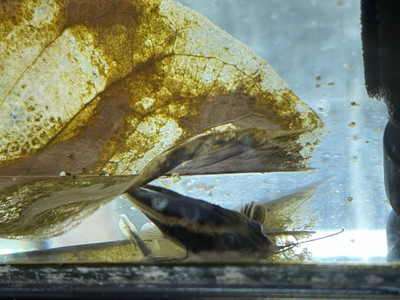Striped Raphael Catfish
Posted by Max Gandara on on 1st Feb 2024
The Striped Raphael Catfish, scientifically known as Platydoras
armatulus, is a captivating species in the world of freshwater
aquariums. Originating from the serene river basins of South America,
this nocturnal fish is celebrated for its unique appearance, peaceful
demeanor, and hardy nature.
The Striped Raphael Catfish is easily recognizable by its robust,
armored body and striking black and white or cream stripes, which run
laterally from head to tail. This coloration not only gives it a
distinctive look but also serves as camouflage against predators in the
wild. Adults can grow up to 6-9 inches in length. They have a flat
underside, a high back, and a head that is covered in bony plates. One
of the most notable features of this species is the presence of sharp
spines on their pectoral and dorsal fins, which they use for both
defense and to lock themselves into hiding spots to avoid being
extracted by predators or unwary aquarists.
Striped Raphael Catfish are native to the tranquil, slow-moving rivers
and streams of South America, particularly within the Amazon River
basin. They prefer soft, sandy or muddy bottoms and are often found
hiding under submerged logs, rocks, or dense vegetation. These
environments provide the cover and security they need during daylight
hours.
Known for their nocturnal habits, Striped Raphael Catfish are most
active during the night when they venture out to feed. During the day,
they prefer to hide in the shadows or bury themselves partially in the
substrate. They are generally peaceful and can coexist with other
non-aggressive species of a similar size, making them an excellent
choice for community aquariums.
In terms of diet, Striped Raphael Catfish are omnivores. In the wild,
their diet consists of invertebrates, small fish, and various plant
matter. In captivity, they are not picky eaters and will accept a wide
range of foods including sinking pellets, frozen or live foods, and
plant-based foods, ensuring a well-balanced diet is vital for their
health.
The reproductive habits of Striped Raphael Catfish in the wild are not
well documented, and breeding them in captivity is quite challenging and
rarely successful. It is known that they are egg layers, and in the few
instances of breeding in captivity, a significant change in water
conditions is often a trigger for spawning.
Currently, the Striped Raphael Catfish is not listed as an endangered
species. However, like many species native to the Amazon basin, they
could be threatened by general habitat destruction, pollution, and the
impacts of climate change. Sustainable practices in the aquarium trade
are essential to ensure that wild populations are not depleted.
The Striped Raphael Catfish is a popular choice among aquarists due to
its unique appearance and peaceful nature. They are relatively easy to
care for but do require a suitably sized tank to accommodate their size
when fully grown. The aquarium should mimic their natural habitat with
plenty of hiding spots and a soft, sandy substrate. They are sensitive
to poor water conditions, so regular water changes and good filtration
are important.
The Striped Raphael Catfish is a fascinating addition to any freshwater
aquarium. Their striking appearance, interesting behaviors, and general
hardiness make them a favorite among aquarists. However, as with any
species, understanding and meeting their specific needs is crucial for
their well-being in captivity. Preserving their natural habitats and
ensuring sustainable practices in the aquarium trade are vital for the
longevity of their populations in the wild.

